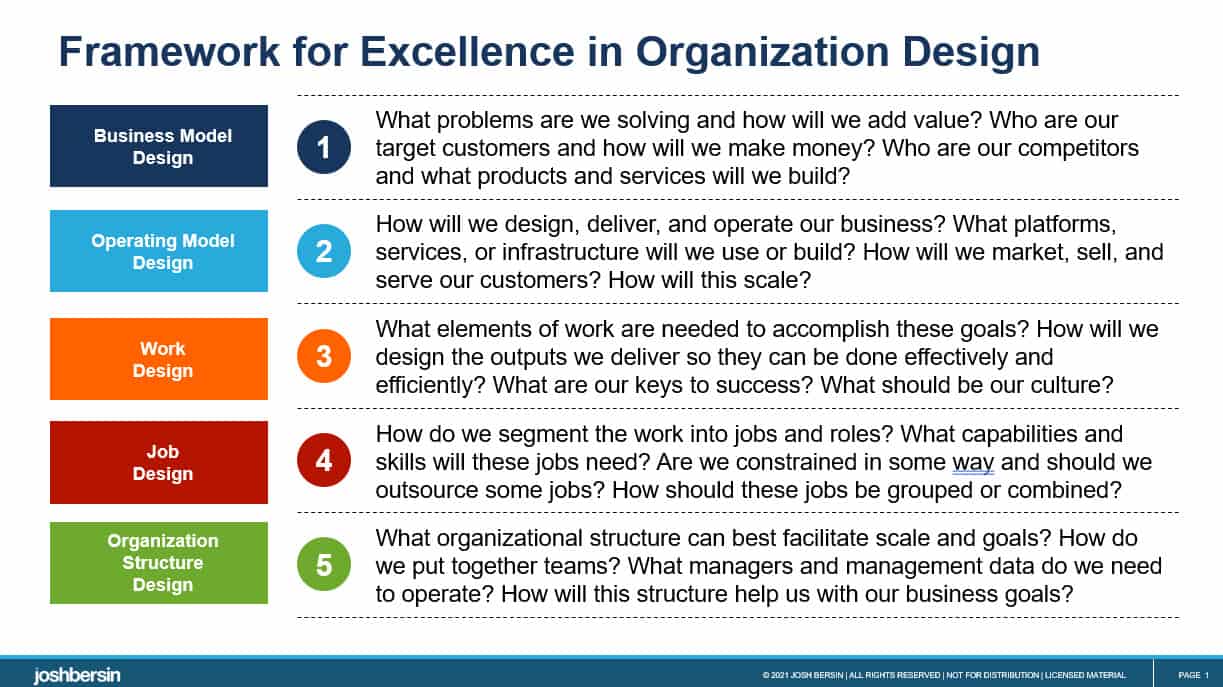How Do You Design Your Organization For The Future?
In all the research we’ve done over the years, the biggest problem of all has yet to be addressed. How do we “design the organization” to perform, scale, and adapt?
Well, we’re in the middle of a massive study of this topic (join this research program here), and let me give you some of our findings.
 |
First, Organization Design is no longer a problem of “spans and layers.”
Most of the work done in this area has focused on increasing the span of control, designing the hierarchy, and clarifying various roles. This is really a business design problem, one that goes to the fundamental issue of what you’re here to do.
For example, most software companies now know that small agile teams perform much faster than large monolithic waterfall groups. Yet how should these teams be set up? Our research shows that even in “team-centric” companies there are a myriad of options. Should we organize around product functions? Technologies? Components?
Consider a sales and marketing organization. Do we organize around customer segment? Industry? Or geography?
These questions have no right or wrong answer, but they’re all questions of strategy. So before you get too bogged down in spans and layers, it’s critical to set out the overall business goals and how the organization helps you achieve these goals.
Second, Organization Design is a craft, not a science.
Every company’s organization will vary, depending on the skills in place, the competitive and industry landscape, and your own point in time. As we interview companies for this work we find consumer package goods companies that have incubator and startup teams coupled with global marketing, sales, and distribution teams. And each company tweaks this depending on their strategy.
For example, one of the most successful food companies has highly empowered general managers in each country. These leaders control sales, marketing, distribution, and even product packaging. Why do they do this? They’ve reached a scale where common product platforms do not generate enough growth, so they’re “localizing products” in many large markets.
Another of our clients is a massive pharma company. They have recently reorganized their R&D function to focus on new biotechnologies and science. While they’ve been organized around drugs and various biological systems for many years, their business is in disruption. So now they have R&D teams dedicated to advanced new biologics, and these teams serve all the other business units.
A third company is a large global professional services company. They, like many companies, have a tendency to “reorganize” around a person. When a team is underperforming, the’ve typically reorganized around a new leader, and then given this leader full reign to reorganize as he or she seems fit. After discussing their successes and failures, the CHRO and senior leaders told us “this is a hit or miss approach.” So they’re working with us to come up with some important rules for the future.
Third, Organization Design must include a sober discussion of constraints.
Right now, for example, it’s unlikely you can rapidly hire at the speed you want. So rather than “wait” until the job market slows down, you may want to outsource or partner to gain the growth you need. Other companies have massive skills gaps, so they may not be sure how to organize for a new domain. These companies fall back on their culture and design around the skills they have.
And what, by the way, is HR’s role in this process? As you’ll learn from our research, HR leaders and business partners play a vital role. Without our professional consulting, business leaders can tend to “wing it.” So your skills are important.
In many ways, Organization Design is the most important thing we do. It encompasses our organizational structure, our rewards system, our culture, and our leadership. And as we’re discovering in our research, in today’s agile work environment we all have a lot to learn.
We welcome you to join us in this research program. You can immediately get involved by participating in this survey, and in the coming months, we’ll be publishing case studies, benchmarks, and specific tools to help.
